- Home
- research-infrastructure
Space
In recent years an important development for Space application has been the use of semiconductor materials based on nitrides. Indeed properties of GaN, AlN, InN and their alloys are well suited to high frequency and high power communications applications. Over the last 30 years the team of the Department of Electronic Engineering is widely recognized for its exceptional contributions to experimental characterization and development of GaN technology and devices: from the design of microwave/millimeter wave systems, to advanced characterization and in the development of innovative models. The UTOV group has a track record in international research collaborations with several companies in this are of reseaerch, i.e. Leonardo, Elettronica, Thales Alenia Space, Rheinmetall, SIAE Microelettronica, STM, OMMIC, UMS, Airbus. Research spans from the characterization and development of advanced components at GaN and the development of innovative GaAs technologies (E/D technology) to the design of integrated subsystems. With the creation of the ISIS @ MACH node, these researches will expand thanks both to the increase in capacity in on-site characterizations and services through new acquisitions of instruments within ISIS@MACH, and to the unique and complementary characterizations that will become available to ISIS. The UTOV teams plan to develop new research and development activities for new nitride-based semiconductor materials, i.e. the design of electronic devices with these materials (mainly HEMT) and the manufacture of systems based on these devices at ISIS@MACH. The physical characterization of these devices is limited today to temperature measurements by Raman and photoconductance. With the creation of the Node the team intends to launch a new material characterization program, which envisages experimental analyzes to be realized – through the platform for “apply for beamtime” – at ISIS@ MACH and at ISIS neutron beamlines, using the complementary neutron techniques of the TOSCA, OSIRIS, MARI, MAPS, WISH beam lines.
References (TO BE ADDED)
Space

References
[2] D. Schaffer, L. Johnson, “Oak Ridge National Laboratory: The First Fifty Years” (The University of Tennessee Press, Knoxville) 1994.
[3] C. Andreani, A. Pietropaolo, A. Salsano, G. Gorini, M. Tardocchi, A. Paccagnella, S. C. D. Frost, S. Ansell, S. P. Platt, “Facility for fast neutron irradiation tests of electronics at the ISIS spallation neutron source”, Appl. Phys. Lett., 92 (2008) 114101.
[5] D. Onorati, C. Andreani, L. Arcidiacono, F. Fernandez-Alonso, G. Festa, M. Krzystyniak, G. Romanelli, P. Ulpiani, R. Senesi; “Gamma background characterization on VESUVIO: before and after the moderator upgrade”Journal of Physics: Conference Series, 1055 (1), 012009 (2018).
Cultural Heritage
Prokaryotic biodeteriogens of library goods parchment
Parchment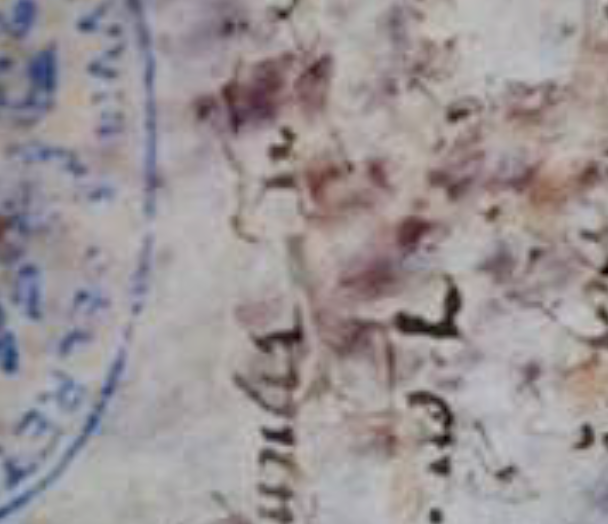 is a semi-solid matrix of collagen produced with animal skin (sheep, goat) consisting of the outermost layer of the dermis, an attractive source of food for the microbial biodeteriogens. Researchers from the Department of Biology have analyzed the causes of biodeterioration of parchment book assets through identification and characterization of prokaryotic biodeteriogens (bacteria and archaea) through Next Generation Sequencing, bioinformatic analysis of metagenomic data and of the structure and community composition.
is a semi-solid matrix of collagen produced with animal skin (sheep, goat) consisting of the outermost layer of the dermis, an attractive source of food for the microbial biodeteriogens. Researchers from the Department of Biology have analyzed the causes of biodeterioration of parchment book assets through identification and characterization of prokaryotic biodeteriogens (bacteria and archaea) through Next Generation Sequencing, bioinformatic analysis of metagenomic data and of the structure and community composition.
With the creation of the ISIS@MACH Node the team intend to expand this approach and apply it to natural (e.g. marine) and associated microbial communities to humans, in order to maximize the monitoring of modern and exogenous DNA contamination and to study a large number of artefacts simultaneously and quickly. The project includes new experimental proposals to be submitted – through the platform “apply for beamtime ” – both to ISIS@MACH, and to ISIS neutron beamlines, using the complementary neutron techniques of the TOSCA, MAPS, IMAT beamlines.
References (TO BE ADDED)
Cultural Heritage
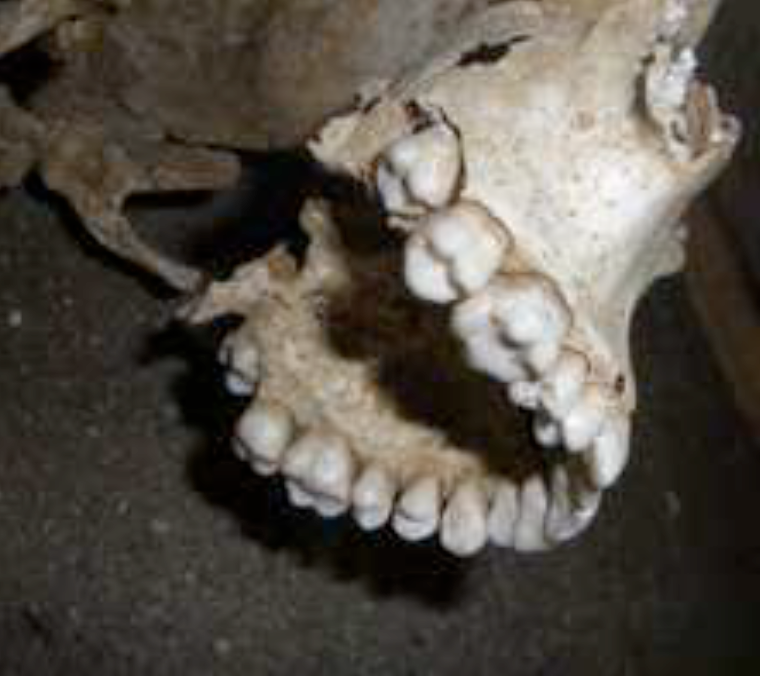 The evolutionary history of Homo sapiens has been characterized by multiple and significant changes in the diet that have changed our gene pool. Furthermore, changes in nutritional regimes have contributed to the modification of the microbiota. The Next Generation Sequencing technique allows you to get a complete picture of the genetic variants that affect nutrition-related diseases.
The evolutionary history of Homo sapiens has been characterized by multiple and significant changes in the diet that have changed our gene pool. Furthermore, changes in nutritional regimes have contributed to the modification of the microbiota. The Next Generation Sequencing technique allows you to get a complete picture of the genetic variants that affect nutrition-related diseases.Over the past three years, researchers from the UTOV Department of Biology, using Next Generation Sequencing technique, have obtained a broad picture of the genetic variants that affect food-related diseases.
References (TO BE ADDED)
Cultural Heritage
“Deterioration of stone monuments”
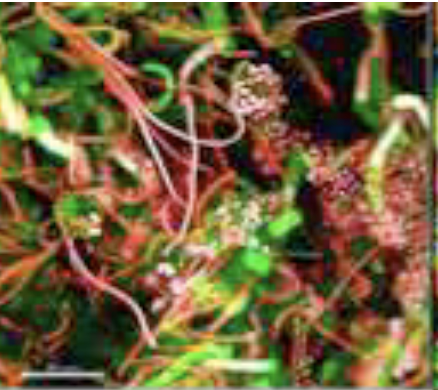 Biodeterioration is the irreversible loss of value and / or information of an art object following the attack of living organisms. Thus the importance of performing morphological and molecular characterization of phototrophic and heterotrophic microorganisms of biofilms that deteriorate stone monuments. The best way to preserve it is to know the nature of phototrophic and heterotrophic microorganisms of biofilms that stone monuments deteriorate. In the last three years researchers from the Department of Biology have made some molecular characterizations of phototrophic and heterotrophic microorganisms of the deteriorating biofilm materials of historical and artistic interest, using the optical microscope, confocal a laser and petrographic scanning. These features have allowed targeted restoration interventions aimed at preserving monuments with their eradication. With the creation of the ISIS@MACH Hub the group of UTOV intends to expand the morphological and molecular characterization activities of microorganisms phototrophs and heterotrophs of biofilm. Project foresees new experimental analyzes to be realized – through the platform for “apply for beamtime”- both at ISIS@MACH, and at ISIS neutron beamlines, using the complementary neutron techniques of the TOSCA, MAPS, IMAT.
Biodeterioration is the irreversible loss of value and / or information of an art object following the attack of living organisms. Thus the importance of performing morphological and molecular characterization of phototrophic and heterotrophic microorganisms of biofilms that deteriorate stone monuments. The best way to preserve it is to know the nature of phototrophic and heterotrophic microorganisms of biofilms that stone monuments deteriorate. In the last three years researchers from the Department of Biology have made some molecular characterizations of phototrophic and heterotrophic microorganisms of the deteriorating biofilm materials of historical and artistic interest, using the optical microscope, confocal a laser and petrographic scanning. These features have allowed targeted restoration interventions aimed at preserving monuments with their eradication. With the creation of the ISIS@MACH Hub the group of UTOV intends to expand the morphological and molecular characterization activities of microorganisms phototrophs and heterotrophs of biofilm. Project foresees new experimental analyzes to be realized – through the platform for “apply for beamtime”- both at ISIS@MACH, and at ISIS neutron beamlines, using the complementary neutron techniques of the TOSCA, MAPS, IMAT.
References (TO BE ADDED)
Cultural Heritage
“Molecular characterization of plant genomes”
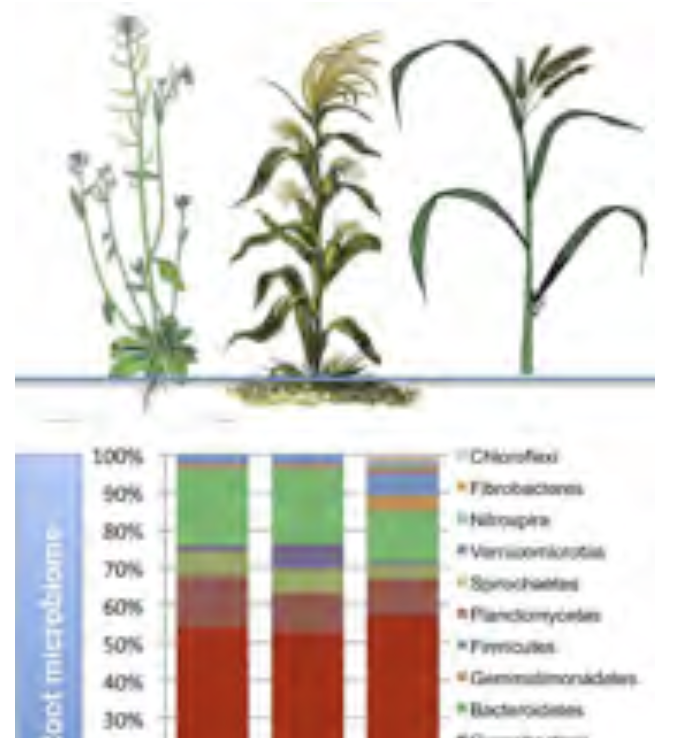 Characterization of plant biodiversity macro and microscopic of a certain environment and of the microbiota associated with plant species (phyllosphere,
Characterization of plant biodiversity macro and microscopic of a certain environment and of the microbiota associated with plant species (phyllosphere,
endosphere and rhizosphere) are of paramount impotance for the understanding the ecosystems and potential of the plants that inhabit it. MicroRNAs have recently been found to be critical in plant gene regulation, from germination to fruiting. Over the past three years researchers from Biology Department carried out quantitative and qualitative analysis of the plant biodiversity present in aquatic and terrestrial samples, using Next Generation Sequencing, in order to monitor their composition and variability following variation of environmental parameters. In addition, the endogenous and radical microbiota of plant species subjected to biotic (e.g. infections) and abiotic (e.g. drought) stresses were investigated and compared with their counterparts present in non-stressed plants, in order to evaluate the influence of these microorganisms (e.g. bacteria, cyanobacteria, fungi, viruses) on the adaptive capabilities of plants. Finally, the study of gene portions coding for microRNA was carried out to assess the impact of these small ones nucleic acid sequences on the evolution and development of plants. With the creation of Node UTOV teams plan to design new experimental project proposals to be realized – through the platform “apply for beamtime” – both at ISIS@MACH, and at ISIS neutron beamlines, using the complementary neutron techniques of the OSIRIS, IRIS, TOSCA, IMAT and MAPS beam lines.
References (TO BE ADDED)
Cultural Heritage
“Paleogenomic analysis of human remains”
 Molecular archeoanthropology exploits the technologies of Next Generation Sequencing (NGS) which allow us to monitor contamination from modern exogenous DNA and to study a large number of finds simultaneously and in a short time. Over the past three years, researchers from the UTOV-NAST Centre, analyzed and characterized human paleogenomes by studying thr ancient DNA extracted from the petrosa of the storm or from the teeth. Final goal whas to understand the genetic composition of populations, to study their relationships and the population dynamics of the various geographical areas, any genetic defects, as well as some genes related to physical appearance.
Molecular archeoanthropology exploits the technologies of Next Generation Sequencing (NGS) which allow us to monitor contamination from modern exogenous DNA and to study a large number of finds simultaneously and in a short time. Over the past three years, researchers from the UTOV-NAST Centre, analyzed and characterized human paleogenomes by studying thr ancient DNA extracted from the petrosa of the storm or from the teeth. Final goal whas to understand the genetic composition of populations, to study their relationships and the population dynamics of the various geographical areas, any genetic defects, as well as some genes related to physical appearance.
Most recently the team performed the first analysis of ancient burned human skeletal remains by neutron and optical vibrational spectroscopy, using an innovative integrated approach. The application of complementary vibrational spectroscopic techniques—INS (inelastic neutron scattering), FTIR (Fourier transform in-frared), and micro-Raman—enabled to access to the complete vibrational profile and constitutes the first application of neutron spectroscopy to ancient bones. Burned skeletal remains are abundant in archaeological and paleontological sites, the result of fire or of ancient funerary practices. In the burning process, the bone matrix suffers structural and dimensional changes thatinterfere with the reliability of available osteometric methods. In this recent studies it has been showed that the macroscopic changes are accompanied by microscopic variations which are reflected in the vibrational spectra. Comparison with data from modern human bones that were subjected tocontrolled burning allowed identification of specific heating conditions. This pioneering study provides archaeolo-gists and anthropologists with relevant information on past civilizations, including regarding funerary, burial, andcooking practices and environmental settings.
With the realization of the Node, the team intends to expand these paleogenomic analysis activities of human remains by launching a new research program on biomaterial characterization, which foresees experimental analyzes to be realized – through the platform “apply for beamtime” – both a ISIS @ MACH, and at ISIS neutron beamlines, using the complementary neutron techniques of the TOSCA, MAPS, IMAT beam lines.
References
G. Festa, C. Andreani, M. Baldoni, V. Cipollari, C. Martínez-Labarga, F. Martini, O. Rickards, M.F. Rolfo, L. Sarti, N. Volante, R. Senesi, F.R. Stasolla, S.F. Parker, A.R. Vassalo, P. Mamede, L.A.E. Batista de Carvalho and M.P.M. Marques, Old burned bones tell us about past cultures, Spectroscopy Europe, 31, 4 (2019)
G. Festa, C. Andreani, M. Baldoni, V. Cipollari, C. Martínez-Labarga, F. Martini, O. Rickards, M.F. Rolfo, R. Senesi, F.R. Stasolla, S.F. Parker, A.R. Vassalo, L.A.E. Batista de Carvalho and M.P.M. Marques. First analysis of ancient burned human skeletal remains probed by neutron and optical vibrational spectroscopy, Science Advances 5, eaaw1292 (2019).
Cultural Heritage
“Neutron Imaging of Ghiberti Golden Heads”
The “Gates of Paradise” of the Baptistery of Florence is one among the greatest masterpieces of the Florentine Renaissance, made by the goldsmith and sculptor Lorenzo Ghiberti between 1425 and 1452.
Two of th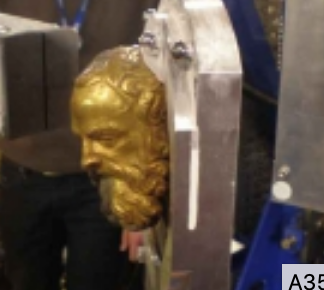 e gilded bronze heads composing the Gates of Paradise panels were characterized with neutron techniques, non-destructivly and non-invasivly. The neutron analysis provided unprecedented information of the alloy composition, the identification of processing and state of conservation of the external gilding. Analysis also allows to identify the presence of a vacuum zone inside the bronze relief.
e gilded bronze heads composing the Gates of Paradise panels were characterized with neutron techniques, non-destructivly and non-invasivly. The neutron analysis provided unprecedented information of the alloy composition, the identification of processing and state of conservation of the external gilding. Analysis also allows to identify the presence of a vacuum zone inside the bronze relief.
Measurements were performed at Tor Vergata and at ISIS neutron facility. The image shows one of the bronze reliefs analyzed on the neutron beamline ENGIN-X and treated using two cleaning techniques: the chemical bath with Rochelle salts and laser cleaning.
The study used neutron beams at the ISIS Spallation Neutron Source (UK) and at Research Neutron Source Heinz Maier-Leibnitz (FRMII) reactor (D). Results provide insight into the manufacturing techniques, alloys composition and the restoration techniques used, for the cleaning procedures i.e. laser polishing and immersion in the Rochelle salts. The investigation revealed for the first time that Ghiberti refused twice one of the gilded bronze relieves. Most likely this was a necessary action Ghiberti had to undertake for the first fusion presented defects.
Further Information
This study were performed in the framework of the Project ‘Ancient Charm’ a NEST (New and Emerging Science and Technology), within the Sixth Framework Programme (FP6); January 2006 – December 2009, supported by European Community.
Ancient Charm Partners
University of Milano-Bicocca (Coordinator), University of Roma Tor Vergata, Hugarian National Museum, Institute for Isotopes- Hungarian Academy of Sciences, Rheinische Friedrich-Wilhelms Universität zu Bonn (Germany), Universität zu Köln (Germany), European Commission – Joint Research Centre – Institute for Reference Materials and Measurements (Belgium), Leiden University (The Netherlands), Technical University of Delft (The Netherlands), Science and Technology Facilities Council (United Kingdom).

Figure 1. Researchers at ISIS spallation neutron source during the experimental campaign in April 2009.

Figure 2. Researchers at ISIS spallation neutron source during the experimental campaign in April 2009.

Figure 3. Researcher at ISIS spallation neutron source during the experimental campaign in April 2009.
References
L. Arcidiacono, M. Martinón-Torres, R. Senesi, A. Scherillo, C. Andreani and G. Festa, “Cu-based alloys as a benchmark for T-PGAA quantitative analysis at ISIS pulsed neutron and muon source”, JAAS, 2019, DOI: 10.1039/C9JA00268E
P. Ulpiani, G. Romanelli, D. Onorati, A. Parmentier, G. Festa, E. Schooneveld, C. Cazzaniga, L. Arcidiacono, C. Andreani and Roberto Senesi, “Optimization of detection strategies for epithermal neutron spectroscopy using photon-sensitive detectors”, Review of Scientific Instruments 90, 073901 (2019); https://doi.org/10.1063/1.5091084.
L. Arcidiacono, A. Parmentier, G. Festa, M. Martinon-Torres, C. Andreani, R. Senesi, “Validation of a new data-analysis software for multiple-peak analysis of gamma spectra at ISIS pulsed Neutron and Muon Source.”, Nuclear Inst. and Methods in Physics Research, A., Nuclear Inst. and Methods in Physics Research, A 938 (2019) 51–55
G. Romanelli, G. Festa, M. Krzystyniak, C. Andreani, F. Fernandez-Alonso and R. Senesi. The road to a station for epithermal and thermal neutron analysis. Journal of Physics: Conf. Series 1055 (2018) 012017
M. Nardini, C. Andreani, R. Senesi, A. Scherillo, F. D’Agostino, L. Romano, C. Scatigno, and G. Festa. Neutron Resonance Capture Analysis and chemometric tools: an integrated approach, Journal of Physics: Conf. Series 1055 (2018) 012005
A. Parmentier, L. Arcidiacono, R. Senesi, G. Romanelli, C. Andreani, J. Moir and G. Festa, ‘Absolute efficiency calibration of a coaxial HPGe detector for quantitative PGAA and T-PGAA’, Journal of Physics: Conf. Series 1055 (2018) 012010
Related Links
Journal of Applied Physics article (2011)
Journal of Applied Physics article (2009)
University of Tor Vergata press release
Cultural Heritage
“Neutrons to illuminate Violins and Egyptian Artefacts“
Scientists captured previously elusive details about ancient Italian violins, by Amati and Testore, and the Egyptian grave-goods of Kha thanks to a new neutron instrument at ISIS, IMAT, which has the ability to reveal hidden images of these objects for the first time. The study have used neutron tomography on IMAT and Engin-X to non-invasively investigate the content of two artefacts from the tomb of ‘Kha and Merit’, a married couple who walked the streets of Ancient Egypt over 3000 years ago
In 1906, the archaeologist Ernesto Schiaparelli and the Inspector of Antiquities, Arthur Weigall, opened the door of the inner chamber of tomb TT8 located on the cliffs surrounding the ancient village of Deir el Medina in Egypt. Little did they know at the time that tomb TT8 was the burial and undisturbed resting place of an 18th Dynasty royal architect named Kha and his wife Merit. Within the tomb was what is now considered the richest and most complete non-royal burial assemblage ever found and housed in a museum outside of Egypt, dating back to the New Kingdom of 1425 – 1353 BC. Now in 2018 – over 100 years since its discovery – an international collaboration of scientists have been using cutting-edge modern neutron technology to unravel secrets about the tomb and its contents.
 The team, led by the Museo Egizio in Turin, were on the hunt for the Seven Sacred Oils of Ancient Egypt, referenced in literature but never discovered. The two artefacts studied at ISIS were a sealed alabaster vase and a metallic situla, taken from a collection of grave goods found at the tomb of upper-class Ancient Egyptians Kha and Merit. The group, led by Guilia Festa from Centro Fermi and Dr Triestino Minniti from the ISIS Neutron & Muon Source, used Raman techniques at Museo Egizio, beamlines IMAT to carry out Neutron Radiography (NR), Neutron Tomography (NT) and Prompt Gamma Activation Analysis (PGAA), whilst ENGIN-X provided further Neutron Diffraction (ND) measurements.
The team, led by the Museo Egizio in Turin, were on the hunt for the Seven Sacred Oils of Ancient Egypt, referenced in literature but never discovered. The two artefacts studied at ISIS were a sealed alabaster vase and a metallic situla, taken from a collection of grave goods found at the tomb of upper-class Ancient Egyptians Kha and Merit. The group, led by Guilia Festa from Centro Fermi and Dr Triestino Minniti from the ISIS Neutron & Muon Source, used Raman techniques at Museo Egizio, beamlines IMAT to carry out Neutron Radiography (NR), Neutron Tomography (NT) and Prompt Gamma Activation Analysis (PGAA), whilst ENGIN-X provided further Neutron Diffraction (ND) measurements.
IMAT bemaline was opened today in the presence of H. E. Pasquale Terracciano, Italian Ambassador in London, by Corrado Spinella, Director of the Department of Physics of the Italian National Research Council (the CNR) and ISIS Director Robert McGreevy, in a celebration of the long-standing partnership between the UK and Italy.
The new imaging capabilities of IMAT enable scientists to access key information on the effects that the choice of different materials in violin has on the sound they produce, as well as the methods used by ancient Egyptians to make vases and alabasters.
 Egyptian Artefact mounted on the neutron beamline
Egyptian Artefact mounted on the neutron beamline
Cultural heritage studies of this kind, along with a number of other research areas, have expanded as a result of the Italian collaboration with the ISIS Neutron and Muon Source, a research facility supported by the Science and Technology Facilities Council. The agreement between CNR and ISIS was originally signed in 1985, making Italy one of the major and longest-standing partners of the research facility.
Today, the relationship between ISIS and Italy was celebrated with the opening of IMAT, the first instrument at ISIS capable of producing 3-dimensional images to reveal the inner workings of components across a wide range of science and technology areas.
H. E. Pasquale Terracciano, Italian Ambassador in London said: “This is a flagship European partnership of which both UK and Italy can be proud. We look forward to the continued success of this partnership far into the future.”
Dr Corrado Spinella, Director of the Department of Physics of the Italian National Research Council (the CNR) said: “It is wonderful to mark this milestone in the relationship between ISIS and Italy. Continued access to ISIS will be a key element of the Italian neutron research infrastructure strategy.”
Professor Robert McGreevy, Director of ISIS added: “We are delighted to be able to celebrate the inauguration of IMAT with our colleagues from CNR and H. E. Terracciano. Our partnership with Italy has brought extensive benefits not just to our two countries but the wider scientific community. The studies taking place today will provide important insights into our cultural heritage. Longer term, we expect to see IMAT enable advances in a wide range of applications, from aerospace, civil engineering and power generation to earth science and agriculture.”
Antonio Stradivari (1644 – 1737) was one of the greatest luthiers of all time. His interpretation of geometry and design for the violin has served as a conceptual model for violin-makers for more than 300 years.
Today a team of scientists from the Italian National Research Council CNR, Tarisio (London), Fondazione Pro Canale (Milan), University of Milano-Bicocca and University of Rome Tor Vergata, are investigating the craftsmanship of ancient Italian violins using neutron beams. The team wishes to explore how the wood, only a few millimetres thick, was used to construct the instrument, and how small details in the finishing and varnishing processes influence the sound production. Due to their peculiar shape and high value, violins are difficult objects to study with standard analytical techniques. IMAT offers a non-destructive method by which the entire instrument can be imaged. These experiments form part of a wider project that aims for the integrated analysis of musical instruments.
More than 3,000 years before Stradivari’s time, between 1425 and 1353 BC, Kha was overseeing the building of tombs for the kings of ancient Egypt. Previously, all that was known about Kha was taken from his mud brick funerary chapel. Until 1906, when an Italian archaeological mission discovered the shaft of Kha’s own tomb that had been sealed by a landslide. It was the richest and most complete non-royal burial assemblage ever found. Kha’s grave goods included coffin tunics, beds, vases and prestigious luxury objects inscribed with royal names, as well as alabaster containers, ceramic vessels and jars for food, oil powders and perfumes, some of which still remain sealed with their contents unknown.
Now, a selection of the Egyptian artefacts taken from Kha’s tomb, including vases and alabasters, are being studied on IMAT as part of the ARKHA project. Using neutron beams, which have a high penetration power in metals, the team will find clues on the methods used by ancient Egyptians to make the bronze vases and pots, as well as the state of their conservation.

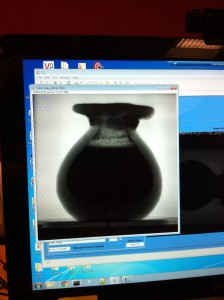
The neutron tomography of a sealed alabaster vessel from the Egyptian Museum of Turin reveals the elemental composition of its contents.
Christian Greco, Director of Museo Egizio said: “On the 2nd of October, 11 vases from the funerary goods of the tomb of Kha have been sent to the ISIS laboratory where they will be studied with the help of neutron beams in order to discover what is hidden inside these precious objects. We strongly believe in the collaboration between archaeologists and researchers in Chemistry and Physics that this project aims at promoting. It is an especially important initiative this year which marks the 110th anniversary of the discovery of the tomb of Kha by Ernesto Schiaparelli, dating back to 1906, because it represents an opportunity to offer to the public new data and useful new results about the objects belonging to our collection”.
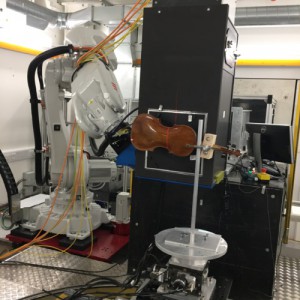 Amati Violin monted on IMAT ready to be scanned
Amati Violin monted on IMAT ready to be scanned
Carlo Chiesa from Fondazione Pro Canale, a Violin maker who acted as a consultant for the project, said: “New analytical methods will help us understand and rediscover techniques that three or four Century ago were a common knowledge in the small community of cremonese violin makers and allowed them to produce the small number of violins that are still unsurpassed for their acoustical properties.”
Prof Carla Andreani, who coordinates the Italian team on behalf of University Rome Tor Vergata added: “The two violins by Amati and Testore became the first ever stringed instruments to be scanned by a neutron beam at ISIS. In a few months, with the combined images produced with the contribution of all the partners of the project, we will be able to complete the elemental analysis using neutron resonances at higher energies and tomography and using thermal neutrons, and provide more complete information on inner structure and morphology of the Violins.”
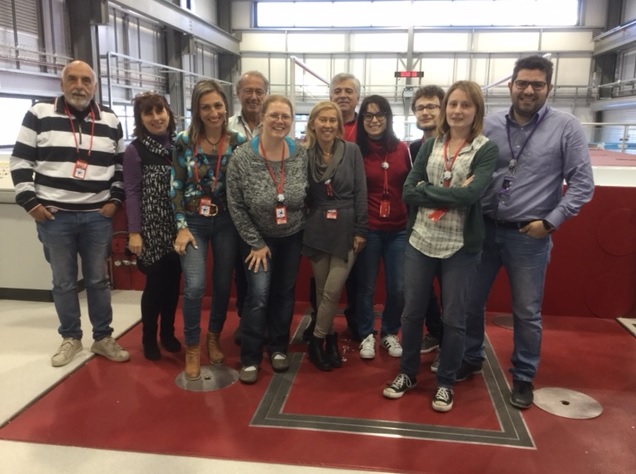
Researchers of University of Rome Tor Vergata, Egyptian Museum, “Archaeology Superintendent, fine arts and landscape for the metropolotana city of Turin”, Historical Museum of Physics and Centre for Studies and Research “Enrico Fermi”, CNR
References
G. Festa, S. L. Lämmlein, R. Senesi, J. Price, C. Chiesa, C. Scatigno, D. Mannes, L. Arcidiacono, R. A. Robinson and C. Andreani, “Effect of coating systems as a barrier to humidity for lutherie woods studied by neutron radiography”, Journal of Cultural Heritage, 10.1016/j.culher.2019.11.004.
G. Festa, T. Christiansen, V. Turina, M. Borla, J. Kelleher, L. Arcidiacono, L. Cartechini, R.C. Ponterio, C. Scatigno, R. Senesi and C. Andreani, Egyptian metallic inks on textiles from the 15th century BCE unravelled by light and neutron probes. Scientific Reports, 9, Article number: 7310 (2019).
G. Festa, C. Andreani, F. D’Agostino, V. Forte, M. Nardini, A. Scherillo, C. Scatigno, R. Senesi and L. Romano, Neutrons for Pottery and Firing Technology at the Sumerian Site of Abu Tbeirah (Southern Iraq). Geosciences 9, 74, 2019. doi:10.3390/geosciences9020074
G. Festa, T. Minniti, L. Arcidiacono, M. Borla, D. Di Martino, F. Facchetti, E. Ferraris, V. Turina, W. Kockelmann, J. Kelleher, R. Senesi, C. Greco and C. Andreani. Egyptian grave goods of Kha and Merit studied by neutron and gamma techniques. Angew. Chem. Int. Ed. 2018, 57, 1 – 6
C. Andreani, F. Aliotta, L. Arcidiacono, M. Borla, E. P. Cippo, D. Di Martino, F. Facchetti, E. Ferraris, G. Festa, G. Gorini, W. Kockelmann, J. Kelleher, D. Malfitana, D. Micieli, T. Minniti, R. Ponterio, G. Salvato, R. Senesi, V. Turina, C. Vasi and C. Greco, ‘A neutron study of sealed ceramic vases from the grave-goods of Kha and Merit’, JAAS, 32, 1342 – 1347 (2017).
Further Information
ARKHA (ARchaeology of the invisible: unveiling the grave goods of KHA) project. Objective of the study is to characterize the “Kha and Merit collection”, by the integrated use of non invasive and non destructive chemical and physical techniques by the integrated use of light and neutron probes. ARKHA combines competences of scientists belonging to different disciplinary fields, i.e curators, restorations, Egyptologists, archeologists, chemists and physicists.
ARKHA project is a collaboration partnership among:
Università degli Studi di Roma Tor Vergata (Coordinator)
Consiglio Nazionale delle Ricerche
Museo Egizio di Torino
Museo Storico della Fisica e Centro Studi e Ricerche “Enrico Fermi”
Soprintendenza Archeologia, Belle Arti e Paesaggio per la Città Metropolitana di Torino
Università degli Studi di Milano-Bicocca
IMAT details
The IMAT beamline is a new instrument at the Science Technology Facilities Council’s ISIS Neutron and Muon Source. It will be the first instrument at ISIS capable of producing 3-dimensional images, revealing the inner workings of components across a wide range of science and technology areas.
The images produced by IMAT will have applications in the areas of aerospace and transportation, civil engineering, power generation, earth sciences, cultural heritage and agriculture. As neutrons can penetrate deeply into materials, IMAT will be capable of producing images of the internal structure of large engineering components. It will reveal, for example, the passage of lubricants and fuel through engine components, and the internal stresses and strains inside welded components.
IMAT has been built using funds provided by the UK government, together with imaging systems developed by Italian scientists from CNR-IPCF, funded through the Italian CNR research council.

The IMAT blockhouse
University of Rome Tor Vergata
ISIS Neutron and Muon Source
Centro Fermi
Tarisio London
Egyptian Museum in Turin
University Milano Bicocca
Related Links
ISIS Neutron and Muon Source on Twitter
BBC clip
TG Leonardo
UK lab helps reveal secrets of 3000 year old Egyptian vases – STFC News
Related Links and Media
University of Tor Vergata
CNR Press Note
Media Gallery
Life Science
“Aggregation of the amylin protein, metal ions and diabetes”
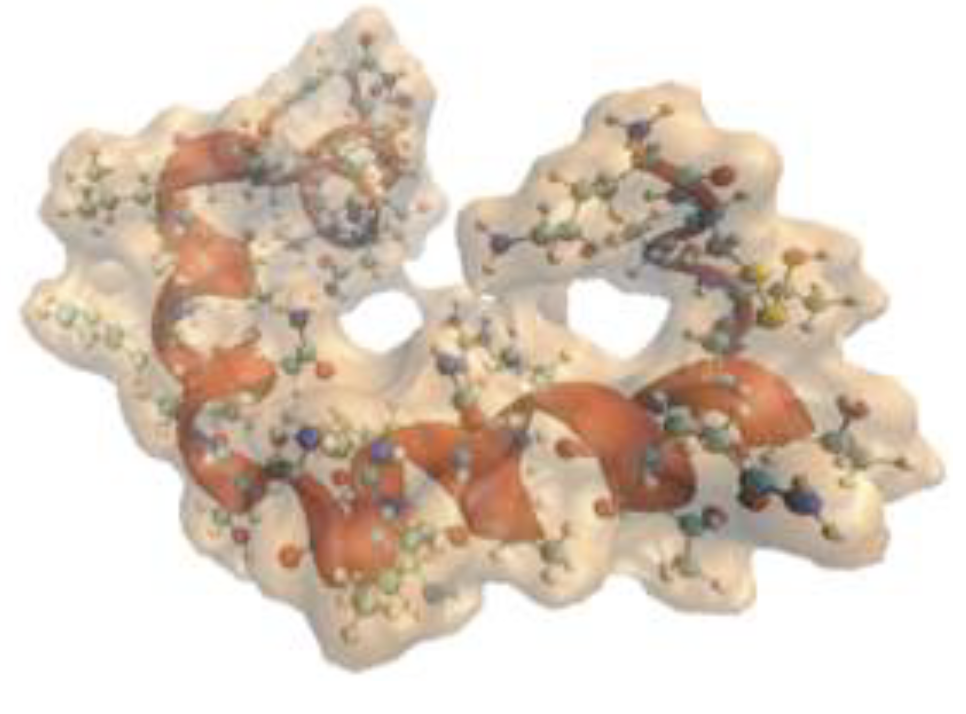 in which the pathogen is not a bacterium or a virus, but a protein molecule. It is therefore necessary to find tools for the therapy of these pathologies, among which is diabetes. In particular, in patients with type II diabetes mellitus they are observed aggregates, also in the form of fibrils, of the amylin protein. The formation of these aggregates is affected from the presence of metal ions, in particular Al (III), Cu (II) and Zn (II). Over the past three years, using the synchrotron radiation, in combination with conventional laboratory techniques such as diffusion dynamics of light and electron microscopy and atomic force, researchers from the UTV investigated – under physiological conditions – the bond between metal ions such as Al (III), Cu (II) and Zn (II) is the amylin peptide and the role played by these ions in the process of formation of fibrils. Following of the realization of the Node, the UTOV group intends to start a new program of biomaterial characterization, which foresees experimental analyzes to be performed – through the platform for “apply for beamtime” – both at ISIS@MACH, and at ISIS neutron beamlines, using IRIS, OSIRIS, SANS, SANS2D beam lines, TOSCA, WISH, offSpec, LARMOR.
in which the pathogen is not a bacterium or a virus, but a protein molecule. It is therefore necessary to find tools for the therapy of these pathologies, among which is diabetes. In particular, in patients with type II diabetes mellitus they are observed aggregates, also in the form of fibrils, of the amylin protein. The formation of these aggregates is affected from the presence of metal ions, in particular Al (III), Cu (II) and Zn (II). Over the past three years, using the synchrotron radiation, in combination with conventional laboratory techniques such as diffusion dynamics of light and electron microscopy and atomic force, researchers from the UTV investigated – under physiological conditions – the bond between metal ions such as Al (III), Cu (II) and Zn (II) is the amylin peptide and the role played by these ions in the process of formation of fibrils. Following of the realization of the Node, the UTOV group intends to start a new program of biomaterial characterization, which foresees experimental analyzes to be performed – through the platform for “apply for beamtime” – both at ISIS@MACH, and at ISIS neutron beamlines, using IRIS, OSIRIS, SANS, SANS2D beam lines, TOSCA, WISH, offSpec, LARMOR.References
De Santis, E., Shardlow, E., Stellato, F., Proux, O., Rossi, G., Exley, C., & Morante, S. (2019). X-Ray Absorption Spectroscopy Measurements of Cu-ProIAPP Complexes at Physiological Concentrations. Condensed Matter, 4(1), 13.
Life Science
“Protein Crystals and Drug Development”
Determining the structure of proteins allows you to understand and modulate 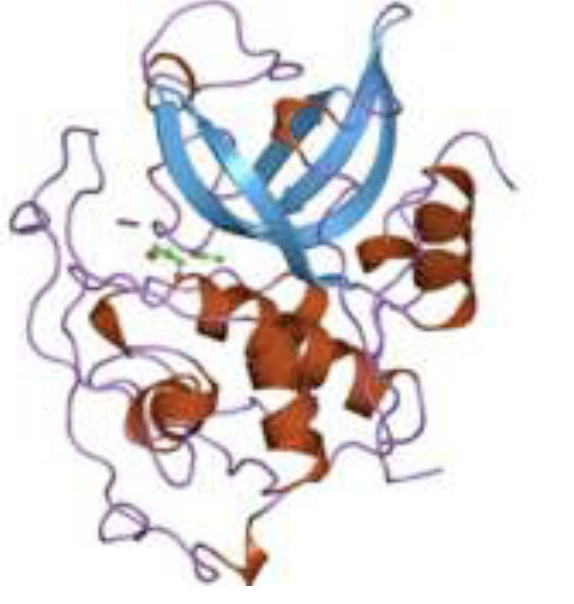 the mechanisms of their functioning and therefore it is fundamental, among others things, in the design of new drugs. Crystallography is the technique of choice for the structural study of proteins and, as appropriate, can use laboratory sources or resort to intense X-ray beams, such as those generated by synchrotrons and free electron lasers, or neutron beams. In the past three years, a team of researchers from Physics Department, used X radiation to carry out diffraction experiments on micro – crystals of catapsin B, a protein involved in the pathogenesis of African sleep fever, a neglected tropical disease, caused by a parasite, which according to the World Health Organization affects tens of millions of people. Such experiments, carried out using optical, electronic and dynamic light scattering techniques for the characterization of the samples and at the free electron laser located in Stanford University laboratories for measurements of diffraction, have allowed to identify some structural differences between the human protein and the disease-causing parasite protein, thus allowing you to design a possible drug in able to hit the parasite without having serious side effects on humans. Following the realization of the Node the team plans to design new experiments on other protein complexes, launching a new biomaterial characterization program to be performed – through the platform “apply for beamtime” – at ISIS@MACH and at ISIS neutron beamlines, using VESUVIO, TOSCA, MAPS, MARI. The latter will allow to identify, in a unique way and with higher resolution, the position of the hydrogen atoms and the water molecules that interact with the protein.
the mechanisms of their functioning and therefore it is fundamental, among others things, in the design of new drugs. Crystallography is the technique of choice for the structural study of proteins and, as appropriate, can use laboratory sources or resort to intense X-ray beams, such as those generated by synchrotrons and free electron lasers, or neutron beams. In the past three years, a team of researchers from Physics Department, used X radiation to carry out diffraction experiments on micro – crystals of catapsin B, a protein involved in the pathogenesis of African sleep fever, a neglected tropical disease, caused by a parasite, which according to the World Health Organization affects tens of millions of people. Such experiments, carried out using optical, electronic and dynamic light scattering techniques for the characterization of the samples and at the free electron laser located in Stanford University laboratories for measurements of diffraction, have allowed to identify some structural differences between the human protein and the disease-causing parasite protein, thus allowing you to design a possible drug in able to hit the parasite without having serious side effects on humans. Following the realization of the Node the team plans to design new experiments on other protein complexes, launching a new biomaterial characterization program to be performed – through the platform “apply for beamtime” – at ISIS@MACH and at ISIS neutron beamlines, using VESUVIO, TOSCA, MAPS, MARI. The latter will allow to identify, in a unique way and with higher resolution, the position of the hydrogen atoms and the water molecules that interact with the protein.
References
Gati, C., Oberthuer, D., Yefanov, O., Bunker, R. D., Stellato, F., Chiu, E., et al. & Beyerlein, K. R. (2017). Atomic structure of granulin determined from native nanocrystalline granulovirus using an X-ray free-electron laser. Proceedings of the National Academy of Sciences, 114(9), 2247-2252.
Stellato, F., Oberthür, D., Liang, M., Bean, R., Gati, C., Yefanov, O., .et al. & Kirian, R. A. (2014). Room-temperature macromolecular serial crystallography using synchrotron radiation. IUCrJ, 1(4), 204-212.
Redecke, L., Nass, K., DePonte, D. P., White, T. A., Rehders, D., Barty, A., Stellato, F., et al. & Williams, G. J. (2013). Natively inhibited Trypanosoma brucei cathepsin B structure determined by using an X-ray laser. Science, 339(6116), 227-230.
Life Science
One of the most complex challenges for modern medicine is the search for new 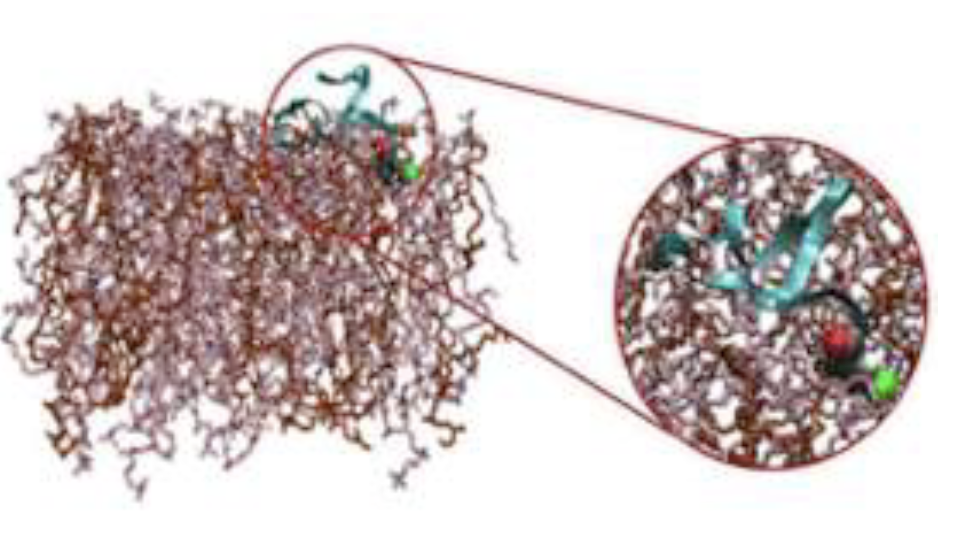 and more effective drugs for the treatment of tumor diseases. A promising attack strategy bythese diseases is based on the design and use of peptides capable of selectively binding to membranes cancer cells. These peptides can be linked to a radioa element, able on one side of damage the cancer cell and on the other hand to conserve it localization. Such a strategy, which combines diagnostics and pathology therapy goes by the name of teranostica. Yes, high performance parallel computing is used to perform simulations of classical molecular dynamics aimed at studying the interaction between a peptide from we engineered and healthy and cancer cell membranes. The peptide has been shown to have an affinity significantly greater for cancer cells than healthy ones. Experiments with calorimetry techniques are being prepared for laboratory confirmation of the results obtained in silico.
and more effective drugs for the treatment of tumor diseases. A promising attack strategy bythese diseases is based on the design and use of peptides capable of selectively binding to membranes cancer cells. These peptides can be linked to a radioa element, able on one side of damage the cancer cell and on the other hand to conserve it localization. Such a strategy, which combines diagnostics and pathology therapy goes by the name of teranostica. Yes, high performance parallel computing is used to perform simulations of classical molecular dynamics aimed at studying the interaction between a peptide from we engineered and healthy and cancer cell membranes. The peptide has been shown to have an affinity significantly greater for cancer cells than healthy ones. Experiments with calorimetry techniques are being prepared for laboratory confirmation of the results obtained in silico.
The image shows the peptide in contact with a tumor membrane.
References
Capozzi, E., Aureli, S., Minicozzi, V., Rossi, G. C., Stellato, F., & Morante, S. (2018). Designing effective anticancer-radiopeptides. A Molecular Dynamics study of their interaction with model tumor and healthy cell membranes. Biochimica et Biophysica Acta (BBA)-Biomembranes, 1860 (11), 2348-2355.
Life Science
“Aliphatic polyesters for regenerative medicine “
 One of the most complex challenges for modern medicine is the search for new and more effective drugs for the treatment of tumor diseases. A promising attack strategy by these diseases is based on the design and use of peptides capable of selectively binding to membranes cancer cells. These peptides can be linked to a radioactive element, able on one side of damage the cancer cell and on the other hand to conserve it localization. Such a strategy, which combines diagnostics and pathology therapy goes by the name of teranostica. Yes, high performance parallel computing is used to perform simulations of classical molecular dynamics aimed at studying the interaction between a peptide we engineered and an healthy or cancer cell membranes.
One of the most complex challenges for modern medicine is the search for new and more effective drugs for the treatment of tumor diseases. A promising attack strategy by these diseases is based on the design and use of peptides capable of selectively binding to membranes cancer cells. These peptides can be linked to a radioactive element, able on one side of damage the cancer cell and on the other hand to conserve it localization. Such a strategy, which combines diagnostics and pathology therapy goes by the name of teranostica. Yes, high performance parallel computing is used to perform simulations of classical molecular dynamics aimed at studying the interaction between a peptide we engineered and an healthy or cancer cell membranes.
The image shows the peptide in contact with a tumor membrane. In the last three year UTV team used high performance parallel computing to perform simulations of classical molecular dynamics aimed at studying the interaction between an engineered peptide and the tumor cell membranes or healthy. The peptide has been shown to have an affinity significantly greater for cancer cells than healthy cells. Experiments with calorimetry techniques are being prepared for laboratory confirmation of the results obtained in silico. Following the realization of ISIS@MACH, the team plans to perform characterizations on new drugs in house at ISIS@MACH and at ther ISIS neutron beamlines IRIS, OSIRIS, SANS, SANS2D, TOSCA, WISH, offSpec and LARMOR.
References (TO BE ADDED)
Life Science
“Confinement of water in two-dimensional graphene oxide structures”
One of the challenges technology in the research and development of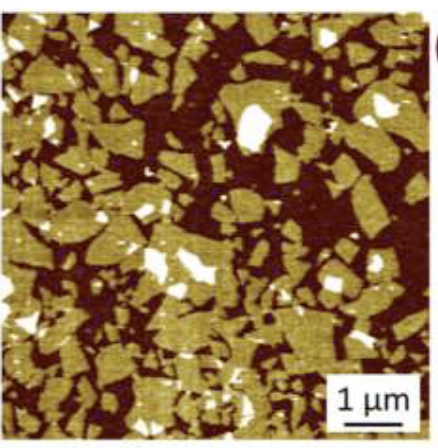 graphene-based materials is the understanding and control of interactions with solvent molecules in aqueous solutions, with the aim of obtaining materials for physiological applications. In this context, the group of the UTOV NAST Center has characterized the interaction between water and graphene oxide substrates, to determine the conditions of confinement in two dimensions and the response of water molecules to hydrophilicity conditions and hydrophobicity of these substrates. The design of the experiment was carried out in the laboratories of UTV and the characterizations of the sample at ISIS using the VESUVIO beam line, usingthe
graphene-based materials is the understanding and control of interactions with solvent molecules in aqueous solutions, with the aim of obtaining materials for physiological applications. In this context, the group of the UTOV NAST Center has characterized the interaction between water and graphene oxide substrates, to determine the conditions of confinement in two dimensions and the response of water molecules to hydrophilicity conditions and hydrophobicity of these substrates. The design of the experiment was carried out in the laboratories of UTV and the characterizations of the sample at ISIS using the VESUVIO beam line, usingthe 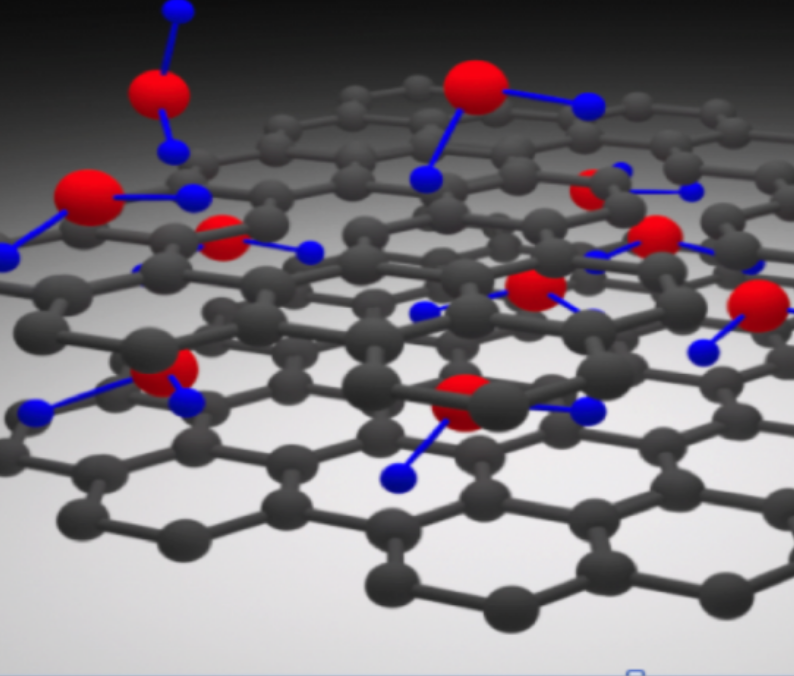 Deep Inelastic Neutron Scattering (DINS) technique. The results made it possible to determine the quantum behavior of hydrogen atoms in confined water. With the creation of the ISIS@MACH node of ISIS it is planned to develop this research and development of graphene-based materials, by launching new characterization project proposals in-house at ISIS@MACH, as well as at ISIS beamline using the neutron techniques at the VESUVIO, MARI, TOSCA and INES beam lines.
Deep Inelastic Neutron Scattering (DINS) technique. The results made it possible to determine the quantum behavior of hydrogen atoms in confined water. With the creation of the ISIS@MACH node of ISIS it is planned to develop this research and development of graphene-based materials, by launching new characterization project proposals in-house at ISIS@MACH, as well as at ISIS beamline using the neutron techniques at the VESUVIO, MARI, TOSCA and INES beam lines.
References (TO BE ADDED)
Life Science
“Self-grafting carbon nanotubes on polymeric supports for stretchable electronics tailored to medical application”
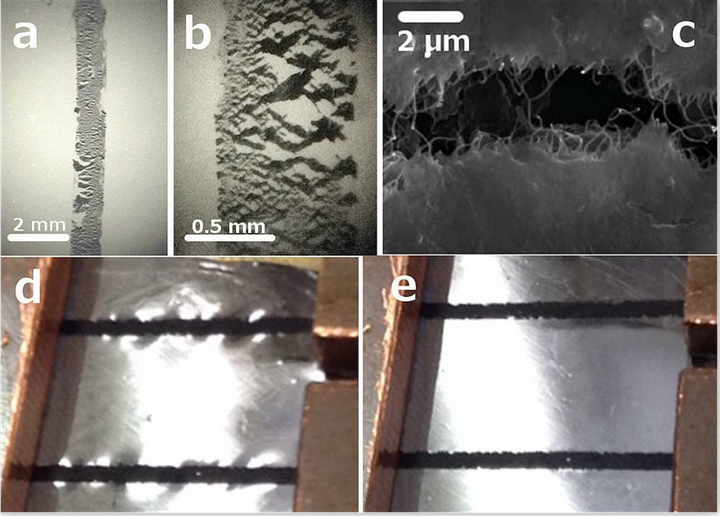 A fundamental requirement for the application of devices to the medical technology sectors is the biocompatibility associated with mechanical characteristics of elasticity and plasticity. Over the last three years, the UTV team has created and characterized polymeric materials, submillimetric flexible-plastic-extensible electrical conductors, for the extraction of cerebral corticogram signals aimed at guiding prostheses and diagnosing and treating epilepsy. The ultimate aim is to replace traditional metal electrodes for detecting the electrical signal from the brain, with detection points distributed with micrometric precision on a polymeric membrane that acts as a meninge. The techniques used for the characterization were optical microscopies, SEM, AFM, and conductance measurements as a function of deformation. Following the creation of the node, the UTV group intends to further expand the research and development of these new polymeric materials, flexible-plastic-extensible electrical conductors, particularly innovative in the most varied industrial sectors, such as electronics and information technology, rehabilitation and prosthetic medicine (prosthesis capable of acquiring signals directly in the brain, mechanical sensors), automotive and aeronautics, environmental sensors (anemometry, flowmeters, etc.), photovoltaics on sails and curtains, fashion (materials for clothes with designs and programmable and editable colors). In these areas, by way of example, the team is currently determining the equivalent impedance according to its geometric shape, the deformation and the relative position of the electrical contacts, the development of systems for analyzing cortical signals for the identification of contributions independent of parameters electrode geometries, and the development of prototypes of antennas based on carbon polymer-nanotube composites for wireless communications. Tasks accomplished include:
A fundamental requirement for the application of devices to the medical technology sectors is the biocompatibility associated with mechanical characteristics of elasticity and plasticity. Over the last three years, the UTV team has created and characterized polymeric materials, submillimetric flexible-plastic-extensible electrical conductors, for the extraction of cerebral corticogram signals aimed at guiding prostheses and diagnosing and treating epilepsy. The ultimate aim is to replace traditional metal electrodes for detecting the electrical signal from the brain, with detection points distributed with micrometric precision on a polymeric membrane that acts as a meninge. The techniques used for the characterization were optical microscopies, SEM, AFM, and conductance measurements as a function of deformation. Following the creation of the node, the UTV group intends to further expand the research and development of these new polymeric materials, flexible-plastic-extensible electrical conductors, particularly innovative in the most varied industrial sectors, such as electronics and information technology, rehabilitation and prosthetic medicine (prosthesis capable of acquiring signals directly in the brain, mechanical sensors), automotive and aeronautics, environmental sensors (anemometry, flowmeters, etc.), photovoltaics on sails and curtains, fashion (materials for clothes with designs and programmable and editable colors). In these areas, by way of example, the team is currently determining the equivalent impedance according to its geometric shape, the deformation and the relative position of the electrical contacts, the development of systems for analyzing cortical signals for the identification of contributions independent of parameters electrode geometries, and the development of prototypes of antennas based on carbon polymer-nanotube composites for wireless communications. Tasks accomplished include:- Design and construction of microfabrication of elastic electrodes matrices based on polyethylene-carbon nanotubes composite which are engineered at points of detection of the electrical signal from the brain, distributed with micrometric precision on a polymeric membrane that acts as a meninge. A first series of devices has been successfully tested in vivo by obtaining a six-channel electrocorticogram for 11 weeks on a rat that is free to move and healthy. The test results are reported in the article “Self-grafting carbon nanotubes on polymers for stretchable electronics”, P. Morales et al., Eur. Phys. J. Plus (2018) 133, 214 [3] and a technical description and videos available at the link in ref [4]. Carbon nanotubes, naturally organized in tangles following growth, endow the composite with its electrical conduction properties, while polyethylene, an excellent electrical insulator and with particularly suitable mechanical properties, constitutes the film that acts as a blood barrier. brain. Both materials are elastic and plastic, and are completely inert and inherently biocompatible. The research, all Italian, therefore has the aim of creating innovative devices to be implanted in the brain to record nerve signals; “Sensors that make a significant contribution to the diagnosis, control and monitoring of neurological diseases, and especially in Brain Computer Interface (BCI) applications, and allow direct connection of the brain with electronic equipment, for example in the case of people with motor or cognitive problems following stroke, trauma or degenerative pathologies, epilepsy “[5];
- development of highly innovative devices that combines the integration and miniaturization of sensors for measuring both physical (i.e. three-dimensional deformation) and chemical (i.e. pH) parameter;
- development of highly innovative devices that combines the integration and miniaturization of sensors for measuring both physical (i.e. three-dimensional deformation) and chemical (i.e. pH) parameters;
- realization of physical sensors with developed technological solutions allow the realization of flexible and biocompatible electrodes for the measurement of mechanical deformations and recording of electrical signals. The solution is based on flexible and extensible electrical conductors that aim to replace traditional metal electrodes. The circuits created are two-dimensional based on carbon nanostructures self-assembled on polymeric substrates, with resistive characteristics tested according to the deformation cycles, and after a suitable calibration, they have already been used in the biomedical field for the recording of electrical activity in the field. neurological [Morales, P. et al. (2018) Eur. Phys. J. Plus 133, 214];
- development of a combined printed device containing miniaturized and biocompatible chemical and physical sensors aimed at a dual and customized application in the neurological and orthopedic fields; a versatile device with academic applicability in the biomedical sector, designed to be integrated with wireless technology (IoT) for remote data management;
- realization of devices / sensors for environment (environmental sensors), medical (rehabilitation and prosthetic medicine, innovative treatments for epilepsy), electronics on film and fabrics, fashion (material materials for clothes with programmable and modifiable designs and colors), photovoltaic (su sails and curtains)
Experimental program proposals are currently in preparation for characterization of novel polymeric materials; these envisage the complementary use of ISIS@MACH instrumentation and of ISIS neutron beam lines OSIRIS, IRIS, TOSCA, INTER, WISH, OffSpec, Larmor, SANS.
References
[1] P. Morales, Liqian Wang, A. Krissanaprasit, C. Dalmastri, M. Caruso, M. De Stefano, L. Mosiello, B. Rapone, A. Rinaldi, S. Vespucci, J. Vinther, S. Retterer, and K. V. Gothelf
“Suspending DNA Origami Between Four Gold Nanodots”, Small 12, No. 2, 169–173, (2016), DOI: 10.1002/smll.201501782
[2] Liqian Wang, C. Dalmastri, A. Krissanaprasit and K. V.Gothelf
“Coupling DNA nano-breaboards to solid state conductors”, EAI Energia, Ambiente e Innovazione 3/2015
[3] P. Morales, S. Moyanova, L. Pavone, L. Fazi, D. Mirabile Gattia, B. Rapone, A. Gaglione, and R. Senesi “Self-grafting carbon nanotubes on polymers for stretchable electronics”, Eur. Phys. J. Plus 133: 214, (2018), DOI 10.1140/epjp/i2018-12040-0
[4] http://centronast.uniroma2.it/res-highlights/neuro-conte-towards-clinical-applications/
[5] ADNKronos, http://www.adnkronos.com/salute/2018/07/13/nanotubi-carbonio-per-monitorare-cervello_pS2rQaraBOtbV3VdhNlMSK.html?refresh_ce
————
« Previous 1 2 3 Next »

